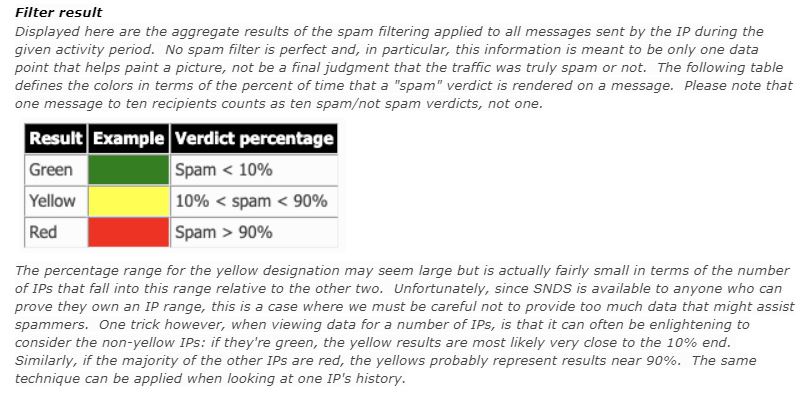
Microsoft’s Smart Network Data Services, also known as SNDS, is a free service offered by Microsoft. Marketers use SNDS to gain insight into some important data about their sender reputation and email deliverability to Microsoft mailboxes.
Data points available from SNDS:
- Number of messages sent from your IP addresses to Microsoft recipients
- Reputation of your sending IP addresses (either green, yellow, or red)
- Amount of bounces
- Bounce percentage
- Complaint percentage
- Spam trap hits
The two most important things to understand when trying to get value from SNDS are sender activity and reputation.
Number of messages sent from your IP addresses to Microsoft recipients:
SNDS will allow you to track how many messages you are sending to the Microsoft network. In many cases, this is a convenient way to track the size of your Microsoft audience in a comprehensive way. Depending on how you track statistics, it can be difficult to account for all of the Microsoft domains, such as hotmail.com, hotmail.co.uk, hotmail.nl, outlook.com, outlook.co.uk, live.com, and msn.com. Using SNDS, you can be more confident you know how much email you are sending to all Microsoft controlled domains.
Reputation of your sending IP addresses:
Experts consider this the most valuable data point from SNDS. Unfortunately, it is also the most confusing, misinterpreted, and misunderstood. SNDS will score your IP address as being green, yellow, or red. To put it simply, green is good, red is bad, and yellow is somewhere in between. Seems simple enough, right? For more detail, let’s take a look at what Microsoft says about this on their FAQ page:

Is all of that clear? Of course not. Let’s try to unpack this and bullet out some important takeaways:
- These colors indicate the verdict from just one layer of Microsoft’s spam filtering infrastructure.
- If your IP address is green, it does not mean less than ten percent of your email is landing in the spam folder. Similarly, if your IP address is red, it doesn’t mean more than 90 percent of your mail is landing in the spam folder.
- Red IP addresses can still reach the inbox and green IP addresses can still have mail sent to the spam folder.
- Your filter result should not be dismissed or ignored, but it should not be the single source of truth for measuring your success or failure delivering to Microsoft mailboxes.
- The range for the yellow designation is huge, but only a small number of IP addresses are scored as yellow.
- The data provided is intentionally vague because if it wasn’t, spammers would abuse it.
If you find yourself with an IP address being consistently scored as red, getting back into the green can be tricky. The first thing you should do is determine if the red verdict is actually correlating with a negative impact on your KPIs. Are conversions actually down? Is site traffic actually down? Is your open rate lower than it used to be? If KPIs are negatively impacted, try to get back into the green.

The first thing you should do is find the best way to reduce your sending volume to Microsoft domains. This could mean temporarily reducing your audience, your sending frequency, or eliminating certain campaigns or message types. Lower sending volume and lower sending frequency will help slow further reputation damage.
Next, you should look for other negative deliverability signals and address those. Are complaints high? Are bounces high? Is engagement low? All three of these issues have different solutions that are probably outside the scope of this article, but work should be done to improve all of these metrics.
The last step you should take is tightening up your engagement-based sunsetting policy. Then, you wait. It can take days or weeks to see a red IP address move to yellow or green. If you’ve taken all of these steps and you’re certain you are being mislabeled, you can open a ticket with Microsoft and plead your case.
Bounces and Bounce Percentage
This metric is simple enough. How many messages did you attempt to send to invalid addresses in the Microsoft Network? In the native SNDS interface, determining bounces and bounce percentage requires some simple math, but with a tool like Validity for Email, we handle the calculation for you and display bounces and bounce percentage as default metric.
Complaint Percentage
This is a big one. Spam complaints are the single most damaging thing that can happen to your sender reputation. The fact that SNDS aggregates and reports on your complaint percentages across the entire Microsoft network is hugely valuable. One important nuance of the complaint percentage metric is it only moves in tenths of a percent. Your complaint percentage will always show 0.1 percent unless it rises above 0.2 percent. The best way to think about this is if you ever see any number other than 0.1 percent in the complaint percentage data, you have a serious problem. Spam complaints should never be higher than 0.1 percent. Really, they should never be higher than 0.08 percent. But when it comes to SNDS data, if you ever see 0.2 percent, you have some soul searching to do.

Spam Trap Hits
Like most mailbox providers, Microsoft operates spam traps to help them identify senders who might be sending unwanted or unsolicited email. Spam traps are mailboxes or domains just like any other, but for one reason or another, it shouldn’t be receiving email. It is either an old, retired domain that used to be valid but has been dormant for a long time, or it is a domain that looks similar to a real domain but is slightly misspelled (hitmail.com versus hotmail.com, or gmall.com versus gmail.com, for example). It is impossible to identify which domains or email addresses are actually Microsoft spam traps. Trying to reverse engineer them is a fool’s errand. What you should do is pay attention to your Microsoft spam trap hits day over day, or week over week, and look for anomalous behavior. Watch for negative trends.
Spam traps are generally reduced or prevented by making positive changes to your address acquisition and retention strategies. The appropriate solution for reducing or eliminating spam traps varies from sender to sender.
Overall, you can see SNDS is a powerful resource for senders with a good portion of Microsoft addresses on their lists. If you identify with that, hopefully this has you on the right path. If you need more help, request a demo today so we can show you how the Validity for Email platform is just the extra hand you need.